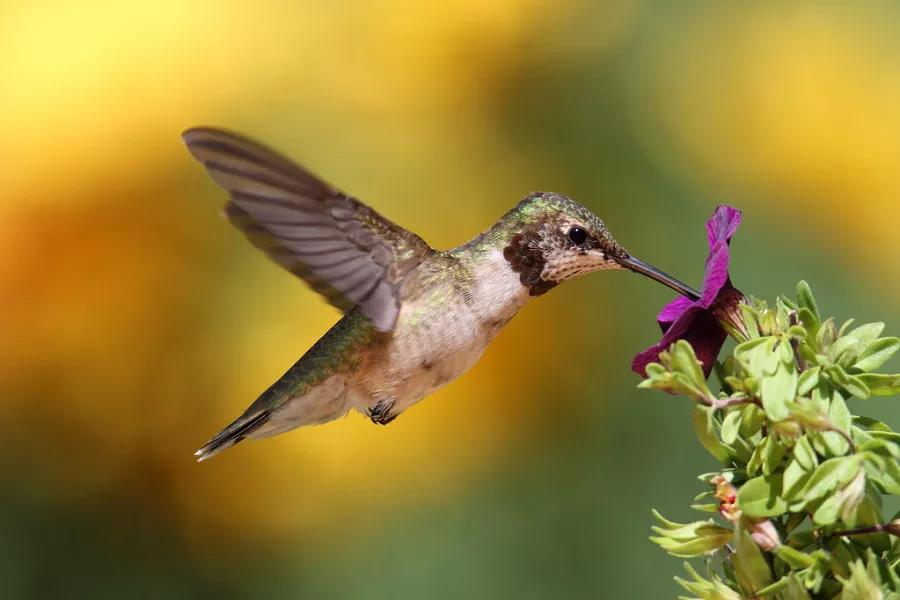Ruby-throated hummingbirds (Archilochus colubris) are remarkable creatures that captivate the hearts of bird enthusiasts and nature lovers alike. Their striking iridescent plumage and incredible flight capabilities make them a joy to observe. However, beyond their mesmerizing appearance and aerial acrobatics lies a fascinating aspect of their biology: their dietary habits. This article delves into the intriguing world of what ruby-throated hummingbirds eat, shedding light on their preferred foods and the role of their diet in sustaining their high-energy lifestyle.
Ruby-throated hummingbird Diet Overview
Ruby-throated hummingbirds are known for their voracious appetites, despite their diminutive size. They are primarily nectarivores, meaning that they primarily feed on the nectar of flowers. Nectar provides these birds with the necessary energy to fuel their rapid wingbeats, which can reach up to an astounding 80 beats per second, allowing them to hover in place, fly backward, and maneuver with precision.
Nectar: The Energetic Fuel
The primary component of a ruby-throated hummingbird’s diet is nectar, which is a sugary liquid produced by various flowering plants. Nectar is rich in carbohydrates, particularly simple sugars like sucrose and glucose. The hummingbirds have specialized tongues that can rapidly lap up nectar from flowers, aided by capillary action. While consuming nectar, hummingbirds inadvertently transfer pollen from flower to flower, playing a crucial role in plant pollination.
Floral Preferences
Ruby-throated hummingbirds are attracted to brightly colored tubular flowers, such as trumpet vines, bee balm, salvias, and columbines. These flowers are adapted to their feeding habits, with long, narrow tubes that accommodate the hummingbirds’ slender bills and tongues. The birds have an exceptional memory for locating reliable nectar sources and can remember the timing of flower blooms in their territory.
Supplementing the Diet
While nectar forms the cornerstone of their diet, ruby-throated hummingbirds also require protein and other nutrients. To supplement their diet, they incorporate small insects and spiders into their meals. These protein-rich food sources provide essential amino acids, vitamins, and minerals that nectar alone may not provide in sufficient quantities.
Hunting Techniques
Ruby-throated hummingbirds are skilled hunters, capable of catching insects mid-air or plucking them from vegetation. They are known to feed on tiny insects like fruit flies, gnats, and spiders. This insectivorous behavior becomes especially prominent during nesting season, as they seek extra protein to nourish their growing offspring.
Migration and Diet
Migration is another factor that influences the dietary habits of ruby-throated hummingbirds. During their long migrations, these birds rely heavily on nectar to sustain their energy levels. This dependence on nectar sources dictates their migration routes, as they must follow a path that ensures access to adequate food along their journey.
Conservation Implications
Understanding the dietary preferences and habits of ruby-throated hummingbirds is essential for their conservation. Loss of habitat and a decrease in nectar-rich flowers due to human activities can impact their survival. Planting native flowering plants in gardens and green spaces can provide these hummingbirds with reliable food sources and contribute to their well-being.
FAQs About Ruby-throated Hummingbird Diet
1. Can they feed from artificial feeders?
Yes, Ruby-Throated Hummingbirds can and do feed from artificial nectar feeders. These feeders often contain a mixture of water and sugar, which mimics the nectar from flowers. It’s important to use the correct sugar-to-water ratio in the feeder to provide a nutritious and safe food source for the hummingbirds. Additionally, keeping feeders clean and free from mold is crucial to the birds’ health.
2. What types of flowers do they prefer for nectar?
Ruby-Throated Hummingbirds are attracted to brightly colored flowers, particularly those that are red, orange, or pink. They prefer tubular-shaped flowers with easily accessible nectar. Some common flower species that attract them include bee balm, trumpet vine, salvia, cardinal flower, and various species of fuchsia.
3. How do they catch insects and spiders?
Ruby-Throated Hummingbirds are known to catch insects and spiders in mid-air using their agile flying abilities. They can hover in place, fly backward, and perform quick aerial maneuvers, which helps them capture small flying insects and spiders. They might also glean insects from leaves and branches.
4. Do they only eat nectar and insects?
While nectar and insects make up the majority of their diet, Ruby-Throated Hummingbirds have been observed consuming tree sap and fruit juices on occasion. They may also visit sap wells drilled by sapsuckers (a type of woodpecker) to feed on the sugary sap that seeps out.
5. Do they migrate for food?
Yes, Ruby-Throated Hummingbirds undertake long migrations between their breeding grounds in North America and their wintering grounds in Central America. Their migration is driven by the availability of food. During the breeding season, they rely on the abundant nectar from flowers, while during the non-breeding season, they seek out areas with reliable nectar sources.
Conclusion
Ruby-throated hummingbirds’ dietary habits showcase their adaptability and uniqueness as a species. Their reliance on nectar and occasional intake of insects allow them to maintain their energetic lifestyle and play a vital role in ecosystem health through pollination. Studying and appreciating their feeding behaviors can lead to better conservation efforts and a deeper appreciation of the delicate balance that sustains these awe-inspiring creatures in the natural world.


 Facebook
Facebook  Instagram
Instagram  Youtube
Youtube 